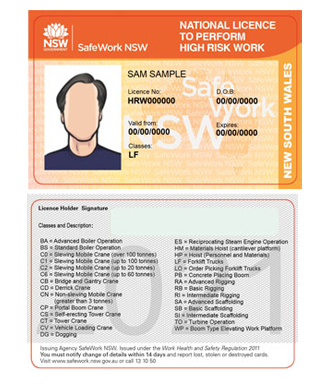
High Risk Construction
Workers often work from a height, use dangerous tools and machinery, and carry out tasks on hazardous building sites. So effective risk management policies and procedures are hugely important for keeping employees, contractors, and site-visitors safe from harm.
What is High Risk Work in Construction?
A high-risk workplace is one where the nature of the work involves high-risk activities and processes – for example, major hazardous facilities, construction sites, or sites with mobile plant.
High Risk Work Licences
To undertake certain types of work in construction the worker involved in High Risk Activity must have a High Risk Work Licence. It must be always kept with you for inspection.
A high risk work licence is required to operate some machinery, erect scaffolding, or undertake dogging or rigging work. You need to apply for a high risk work licence and remain compliant with health and safety laws. High risk work licences are valid for five years and recognised nationally: you can work in any state or territory if you have a current HRW licence.

18 High Risk Construction Work (HRCW) Activities

Risk of a person falling more than 2 metres

Work on a telecommunication tower

Demolition of a load-bearing structure

Work on or near chemical fuel or refrigerant lines

Work on or near energised electrical installation or services

Work in an area that may have a contaminated or flammable atmosphere

Likely to involve disturbing asbestos

Temporary load-bearing support for structural alterations or repairs (Scaffolding)

Work in or near a confined space

Tilt-up or precast concrete elements

Work on, in or adjacent to a road, railway, shipping lane or another traffic corridor in use by traffic other than pedestrians

Work in an area with the movement of a powered mobile plant

Use of explosives

Work in or near a shaft or trench deeper than 1.5m or a tunnel

Work on or near pressurised gas mains or piping

Work in areas with artificial extremes of temperature

Work in or near water or other liquid that involves a risk of drowning

Diving work
SAFE WORK METHOD STATEMENT FOR HIGH RISK CONSTRUCTION WORK
A SWMS is a document that sets out the high risk construction work activities to be carried out at a workplace, the hazards arising from these activities and the measures to be put in place to control the risks.
A SWMS must:
- Identify the work that is high risk construction work
- Specify hazards relating to the high risk construction work and the risks to health and safety
- Describe the measures to be implemented to control the risks
- Describe how the control measures are to be implemented, monitored, and reviewed.
A SWMS Document must be Read, Understood and Signed off by all working parties who are working under the SWMS Document.
A current High Risk Work Licence must be made available for inspection at all times.
